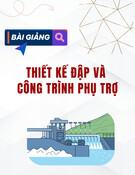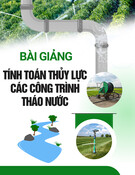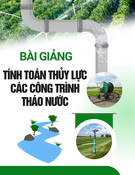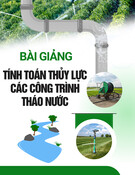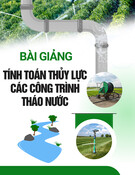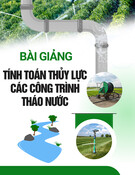
Journal of Water Resources & Environmental Engineering - No. 87 (12/2023)
71
Interactive effects of temperature and cu on distinct life stages
of common tropical copepod across generations
Pham T. Hong
1*
, Hoang Bao Linh
1
, Nguyen Thuy Duong
1
,
Le Thi Thanh Tra
2
Abstract:
The tropical water environment faces increasing exposure to temperature extremes and
contaminants stemming from human activities. Elevated temperatures and pollution levels in rivers and
pon
ds have the potential to induce cumulative impacts on the diversity of aquatic ecosystems. However,
the combined effects of these environmental changes on the life cycle of the Eucyclops euacanthus
copepod, a bioindicator of aquatic ecosystem remain under
studied. Our investigation delved into the
direct and cross-
generational impacts of very low copper concentration (50 µg/l) on the F0 and F1
generations of the common tropical copepod Eucyclops euacanthus under not extreme temperatures (24,
28, and 30 °C).
In the F0 generation, Cu exposure did not alter the life cycle period of the copepod at 24
and 28°C, but an extension was observed at 30 °C. This lengthening of the life cycle at 30 °C in F0
copepods indicates a heightened energetic demand. In the F1 gene
ration, the life cycle period was
elevated in Cu-exposed F0 and at 34 °C. Notably, eggs from Cu-
exposed F1 copepods at 30 °C failed to
hatch successfully. These findings underscore the high vulnerability of tropical copepods to the
combined effects of cont
aminants and temperatures in the contest of climate change effects on the water
ecosystem.
Keywords: Tropical copepod, life-history traits, thermal effects, climate change, metal effects.
1. Introduction
*
Climate change has profound impacts on
aquatic life in various ways such as reducing
aquatic biodiversity, increasing temperature,
and destroying habitats by disrupting aquatic
food chains (Doan, Vu et al. 2019). Among
these impacts, altering the thermal conditions of
aquatic environments by raising global
temperature was the most concerning(Saiz,
Griffell et al. 2022). This is particularly
concerning because numerous species of fish,
invertebrates, and other aquatic organisms
exhibit high sensitivity to temperature
variations, impacting their metabolism, growth,
1
Department of Environmental Engineering and
Management, Faculty of Chemistry and Environment,
Thuyloi University
2
Department of Chemistry Engineering, Faculty of
Chemistry and Environment, Thuyloi University
*
Corresponding author; Email: hongpt@tlu.edu.vn
Received 3
rd
Dec. 2023
Accepted 27
th
Dec. 2023
Available online 31
st
Dec. 2023
and reproductive processes(Scheffler, Barreto et
al. 2019, von Weissenberg, Mottola et al. 2022).
Aquatic ecosystems are facing a rising array
of overlapping stressors originating from human
activities, including pollutants and the impacts
of climate change(Nilsson, Jakobsen et al.
2017). Therefore, studying the interactive
impacts of temperature and pollutants has
resulted in attention. A growing number of
studies have also documented the interactive
effect of climate change and pollutants on
aquatic animals (Dinh, Nguyen et al. 2020). To
investigate the ecological effects of multiple
stressors such as temperature and contaminants,
studies typically focus on the directly exposed
generation. However, there is increasing
concern that the impacts of stressors such as
contaminants may be carried over from parents
to offspring (Corrales, Thornton et al. 2014,
Dao, Wiegand et al. 2018). In freshwater
ecosystems, the carryover effect of stressors

Journal of Water Resources & Environmental Engineering - No. 87 (12/2023)
72
such as pesticides (Tran, Janssens et al. 2019)
reduces the fitness of parents to offspring.
Carryover effects have yet to be tested on the
duration of circle life of tropical ecosystems.
Among aquatic animals, copepods play a major
role in providing biomass for the food chain in the
water environment. Additionally, they serve as
indicators reflecting the adverse effects of climate
change on aquatic ecosystems (Lee, Kim et al.
2022). Consequently, it is imperative to conduct
comprehensive investigations into the
foundational biological aspects of numerous
copepod species, encompassing natural life-cycle
information, dietary preferences, morphology,
behavior, and tolerance to environmental variables
(McGinty, Barton et al. 2021). While there is a
wealth of biological information on diverse
copepod species, a notable gap exists in our
understanding of the tropical copepod species
Eucyclops euacanthus. This particular copepod is
highly responsive to temperature variations and
stands as the indigenous copepod species in the
ASEAN region(Dumont 2006).
In this study, we tested two hypotheses. (1)
The effect of Cu exposure, would be stronger
under extreme temperatures. (2) The effect of
parental exposure to Cu would affect to duration
of the life circle of Eucyclops euacanthus.
2. Materials and methods
2.1. Study species
The copepod Eucyclops euacanthus is
abundant in ponds and lake ecosystems in the lake
ecosystem located in the northern part of Vietnam.
Around 1000 males and females were collected
from a Tuy Lai lake, a shallow waterbody in
Hanoi, Vietnam. The samples were promptly
transported to the laboratory within 4 hours. The
copepod underwent a two-generation acclimation
period of 40 days before being taken part in the
ecotoxicological experiments.
2.2. Food and culture
During the experiment, Eucyclops
euacanthus were fed ad libitum with Chlorella
vulgaris. The experiment was conducted under
the ambient light and photoperiod (12 h light:
12 h dark cycle) maintaining a pH of 7. To
assess the impact of Cu and temperature
exposure on the density of on the Chlorella
vulgaris we exposed Chlorella vulgaris to one
of four treatments: 2 Cu levels (0 and 50 μg
Cu/L) × 2 temperatures (28 °C and 30 °C) for
24 h without copepods. Each treatment was
replicated five times, resulting in a total 20
experiment glass cups (100ml). The initial and
final algal densities were estimated by counting
the number of cells in 1 mL samples using
Sedgwick Rafter counting chamber (PYSER-
SGI, England). The minimum algal density
recorded was 72,000 cells/ml, which was the
saturation food level for Eucyclops euacanthus.
2.3. Screening experiment
The 1 g/l Cu stock solution of was made by
dissolving CuSO
4
*5H
2
O (purity > 99%, Merck,
Germany) in Deion water. The acute toxicity test
was used in the screening experiment to find out
Cu concentration used in the chronic toxicology
test. Females Eucyclops euacanthus were exposed
to a series of Cu concentrations: 0, 30, 50, 100,
200, 500, 750, and 1000 μg/l in pH = 7 for 24 h,
and the survival of each sex was scored. In this
experiment, we opted for females as they are more
sensitive to copper than males.
EC50 value is calculated according to the
probit algorithm as described in formula 1. In
this study, the EC50 values was calculated by
Medcalc model in website
https://www.mdcalc.com/
The probit regression equation has the form:
( )
probit p a b X
Where X is the (possibly log-transformed) dose
variable and probit(p) is the value of the inverse
standard normal cumulative distribution.
The 50 µg/l Cu concentration used in this
study falls within the Cu concentrations that have
been recently recorded in Hanoi Lake (Pham,
Van Dinh et al. 2020) . Notably, this

Journal of Water Resources & Environmental Engineering - No. 87 (12/2023)
73
concentration is approximately one order of
magnitude lower than the limit stipulated by
Vietnamese regulations for coastal waters, which
is 200 μg Cu/l in QCVN-10-MT-2015-BTNMT,
Vietnamese Ministry of Natural Resources and
Environment, 2015(Agency 2015).
The temperature of 28 °C is the mean
temperature measured in the field from March
to May 2018, and the temperature of 30 °C
simulated a short-term extreme temperature that
occurs from several days to weeks in the Hanoi
lakes, Vietnam. A temperature of 24°C serves as
the baseline for comparison with the two
temperatures mentioned above.
2.4. Experiment and set up
To investigate the impact of temperature and
Cu exposure on the copepod Eucyclops
euacanthus, we exposed adults (5 males + 5
females per 2-liter experimental beakers, 5
replicates per treatment) to one of two Cu
treatments (0 and 50 μg/L) × 3 temperature
levels (24- room temperature, 28 and 30 °C) for
2 generations during 40 days. The experimental
units were 2 liters of glass beakers filled with
1.5 of the exposure solutions that were pre-
acclimated to the experimental temperatures.
The exposure solutions and algal food were
renewed every 3 days. At the end of the seven-
day exposure period, surviving females were
transferred to a clean culture to produce nauplii
to start the F1 generation. The experimental
procedures underwent modifications based on
the methodologies employed by Hong et al
(Pham, Dinh et al. 2020) and Khuong et al
(Khuong V. Dinh 2020).
2.5. Response parameters
Females carrying two egg sacs produced
nauplii for 30 h in clean water (without Cu).
The collected nauplii were then transferred and
raised in 2 litter glass bottles until reaching
adulthood at their corresponding temperatures.
Information regarding the development time of
developmental stages was recorded. After a
period of 22 days, the females from the F0
generation (depending on survival) were utilized
for nauplii production. We observed and
confirmed the morphology of 30 individuals at
each developmental stage of Eucyclops
euacanthus. We ran T-test to test for the effects
of, temperature and Cu on development time,
mortality, and nauplii production on Eucyclops
euacanthus across 2 generations.
3. Results and discussion
3.1. Effect of Cu on Acute Toxicity Test
Female Eucyclops euacanthus were exposed to
a series of six Cu concentrations: 0, 30, 50, 100,
250, 500, 750, and 1000 μg/l and three
temperatures (24, 28, and 30C) for 24h. The
survival was recorded. Results showed that survival
strongly decreased at the Cu concentrations of
380.31 and 1000 µg/L, and this pattern was more
pronounced at 30°C than at 28°C.
Figure 1. EC
50
values of Cu in different
temperatures

Journal of Water Resources & Environmental Engineering - No. 87 (12/2023)
74
Figure 1 showed no discernible impact of Cu
at 50 µg/L on EC50 values at three temperatures
(24°C, 28°C, and 30°C). The EC50 values from
experiments conducted at higher temperatures
(30°C and 28°C) were 381.31 and 418.86 µg/L,
respectively, which were lower than those
recorded at room temperature. This suggests
that Cu exhibits increased toxicity in higher-
temperature environments.
3.2. Direct impacts of temperature and Cu
on different developmental stages of F0
In general, copepod has13 distinct life stages
illustrated in the Figure 2. In this study we
measure the life-history traits based on 4 parts
including egg, six naupliar stages, five
copepodite stages and adult which making
development easy to trace.
Figure 2. 13 distinct life stages of copepod
Source: (NOAA 2023)
Temperature and Cu separated effect on F0
life-history traits
The findings indicate that elevated
temperatures of 28°C and 30°C extend the
duration of the egg period. Under normal room
temperature conditions, eggs typically hatch
after 7 days ( shown in figure 3). However,
when subjected to 28°C and 30°C, the hatching
time increases to 8 and 10 days, respectively.
This suggests that temperature has a significant
impact on egg hatching (P < 0.01).
Figure 3. Temperature effects to
F0 life-history traits
Numerous prior studies have affirmed the
influence of temperature on egg hatching.
Within the temperature range of 15°C to 24°C,
eggs demonstrate a higher likelihood of
acclimating and hatching successfully compared
to lower temperatures (Hansen, Drillet et al.
2010). However, higher temperatures tend to
impede and delay the development of eggs and
their hatching process. While we observed a
decrease in the developmental rate of the
copepod at 30°C, there was an increase in
development at 28°C, evident in both naupliar
and five copepodite stages. This phenomenon
may result from enhanced metabolism or
physiological changes triggered by the
temperature elevation in zooplankton (Ebert
1992, Chopelet, Blier et al. 2008)
Our findings reveal that a concentration of 50
ug/l has no significant effect on the
developmental rate of the copepod (P = 0.68)
which was shown in figure 4. This implies that
copper (Cu) does not play a role in influencing
the development of the F0 copepod.

Journal of Water Resources & Environmental Engineering - No. 87 (12/2023)
75
Figure 4. Cu effects to F0 life-history traits
Temperature and Cu interactive effect on F0
life-history traits
The data indicates that there is an
interactive effect between temperature and
copper (Cu) on the developmental stages of
the copepod. The interaction of Cu with
temperatures of 28°C and 30°C significantly
alters the duration of the copepod's egg stage
and the five-copepodite stage (P < 0.01). In
contrast, the interaction of Cu with 28°C
significantly affects the duration of the six-
naupliar stage, and the cumulative effects of
Cu with 30°C can significantly alter the
duration of the six-naupliar stage. Notably, the
combination of temperature and Cu at 50 ug/l
does not impact the adult stage shown in
figure 5. The influence of both temperature
and Cu may be linked to the upregulation of
heat shock.
Protein levels, representing a general
mechanism in organisms coping with
suboptimal metal effects.
We found evidence for the strong
synergistic effects (Crain et al., 2008; Folt et
al., 1999) of temperature and Cu as indicated
by the substantial lengthening of the period of
different developmental stages of the copepod
when two stressors were present. Our results
support earlier findings that showed
synergistic effects of metals and temperature
on the fitness of aquatic organisms (Janssens,
Roelofs et al. 2009, da Silva Fonseca, de
Barros Marangoni et al. 2017). Several
explanations have been proposed for the
elevated vulnerability of aquatic animals to
metals at higher temperatures. Included
among these are 1) a higher rate of metal
uptake and accumulation than excretion, 2)
impairments affecting energy metabolism, 3)
reduced ability to defend against a higher
level of oxidative stress, and 4) higher toxicity
of metals at elevated temperature (Sokolova
and Lannig 2008, da Silva Fonseca, de Barros
Marangoni et al. 2017)
Figure 5. Temperature and Cu interactive
effect on F0 life-history traits
3.3. Accommodative effect of temperature
and Cu on the development stage of F1
generation
The figure 6 demonstrates the temperature's
impact. At 28°C, increased temperature
significantly influences the life cycle period of
copepods (P < 0.01) in F1, while no significance
is observed in the F0 generation.

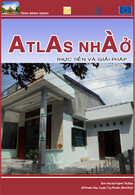
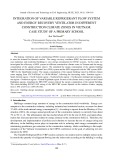
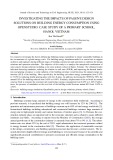
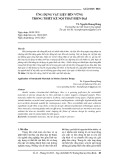

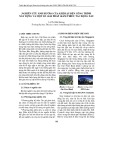
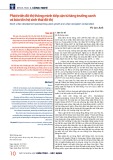

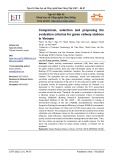
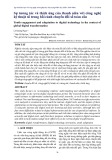
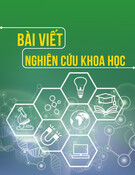



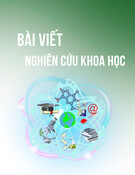
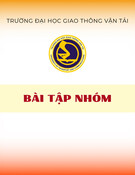
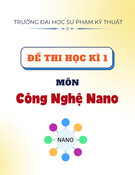
![Bài giảng Quản lý vận hành và bảo trì công trình xây dựng [chuẩn nhất]](https://cdn.tailieu.vn/images/document/thumbnail/2025/20251006/agonars97/135x160/30881759736164.jpg)
